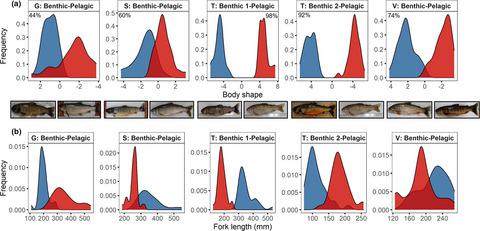当前位置:
X-MOL 学术
›
Ecol. Evol.
›
论文详情
Our official English website, www.x-mol.net, welcomes your feedback! (Note: you will need to create a separate account there.)
The interaction of resource use and gene flow on the phenotypic divergence of benthic and pelagic morphs of Icelandic Arctic charr (Salvelinus alpinus)
Ecology and Evolution ( IF 2.6 ) Pub Date : 2021-05-02 , DOI: 10.1002/ece3.7563 Matthew K Brachmann 1 , Kevin Parsons 2 , Skúli Skúlason 3, 4 , Moira M Ferguson 1
Ecology and Evolution ( IF 2.6 ) Pub Date : 2021-05-02 , DOI: 10.1002/ece3.7563 Matthew K Brachmann 1 , Kevin Parsons 2 , Skúli Skúlason 3, 4 , Moira M Ferguson 1
Affiliation

|
Conceptual models of adaptive divergence and ecological speciation in sympatry predict differential resource use, phenotype–environment correlations, and reduced gene flow among diverging phenotypes. While these predictions have been assessed in past studies, connections among them have rarely been assessed collectively. We examined relationships among phenotypic, ecological, and genetic variation in Arctic charr (Salvelinus alpinus) from six Icelandic localities that have undergone varying degrees of divergence into sympatric benthic and pelagic morphs. We characterized morphological variation with geometric morphometrics, tested for differential resource use between morphs using stable isotopes, and inferred the amount of gene flow from single nucleotide polymorphisms. Analysis of stable isotopic signatures indicated that sympatric morphs showed similar difference in resource use across populations, likely arising from the common utilization of niche space within each population. Carbon isotopic signature was also a significant predictor of individual variation in body shape and size, suggesting that variation in benthic and pelagic resource use is associated with phenotypic variation. The estimated percentage of hybrids between sympatric morphs varied across populations (from 0% to 15.6%) but the majority of fish had genotypes (ancestry coefficients) characteristic of pure morphs. Despite evidence of reduced gene flow between sympatric morphs, we did not detect the expected negative relationship between divergence in resource use and gene flow. Three lakes showed the expected pattern, but morphs in the fourth showed no detectable hybridization and had relatively low differences in resource use between them. This coupled with the finding that resource use and genetic differentiation had differential effects on body shape variation across populations suggests that reproductive isolation maintains phenotypic divergence between benthic and pelagic morphs when the effects of resource use are relatively low. Our ability to assess relationships between phenotype, ecology, and genetics deepens our understanding of the processes underlying adaptive divergence in sympatry.
中文翻译:

资源利用和基因流的相互作用对冰岛北极红点鲑 (Salvelinus alpinus) 底栖和中上层形态差异的影响
同域适应性分化和生态物种形成的概念模型预测了不同的资源利用、表型与环境的相关性以及不同表型之间基因流的减少。虽然过去的研究已经对这些预测进行了评估,但很少对它们之间的联系进行集体评估。我们研究了来自冰岛六个地区的北极红点鲑( Salvelinus alpinus )的表型、生态和遗传变异之间的关系,这些地区经历了不同程度的分化为同域底栖和中上层形态。我们用几何形态计量学表征了形态变异,使用稳定同位素测试了形态之间的差异资源利用,并从单核苷酸多态性推断了基因流的量。对稳定同位素特征的分析表明,同域形态在不同种群的资源利用方面表现出类似的差异,这可能是由于每个种群内生态位空间的共同利用所致。碳同位素特征也是体形和体型个体差异的重要预测因子,表明底栖和中上层资源利用的变化与表型变异相关。同域变体之间杂交的估计百分比因种群而异(从 0% 到 15.6%),但大多数鱼类具有纯变体的基因型(祖先系数)特征。尽管有证据表明同域形态之间的基因流减少,但我们没有发现资源利用差异与基因流之间预期的负相关关系。三个湖泊显示出预期的模式,但第四个湖泊的变形没有显示出可检测到的杂交,并且它们之间的资源利用差异相对较小。再加上资源利用和遗传分化对不同种群的体形变化有不同影响的发现表明,当资源利用的影响相对较低时,生殖隔离维持了底栖和中上层形态之间的表型差异。我们评估表型、生态和遗传学之间关系的能力加深了我们对同源性适应性分歧背后过程的理解。
更新日期:2021-06-22
中文翻译:

资源利用和基因流的相互作用对冰岛北极红点鲑 (Salvelinus alpinus) 底栖和中上层形态差异的影响
同域适应性分化和生态物种形成的概念模型预测了不同的资源利用、表型与环境的相关性以及不同表型之间基因流的减少。虽然过去的研究已经对这些预测进行了评估,但很少对它们之间的联系进行集体评估。我们研究了来自冰岛六个地区的北极红点鲑( Salvelinus alpinus )的表型、生态和遗传变异之间的关系,这些地区经历了不同程度的分化为同域底栖和中上层形态。我们用几何形态计量学表征了形态变异,使用稳定同位素测试了形态之间的差异资源利用,并从单核苷酸多态性推断了基因流的量。对稳定同位素特征的分析表明,同域形态在不同种群的资源利用方面表现出类似的差异,这可能是由于每个种群内生态位空间的共同利用所致。碳同位素特征也是体形和体型个体差异的重要预测因子,表明底栖和中上层资源利用的变化与表型变异相关。同域变体之间杂交的估计百分比因种群而异(从 0% 到 15.6%),但大多数鱼类具有纯变体的基因型(祖先系数)特征。尽管有证据表明同域形态之间的基因流减少,但我们没有发现资源利用差异与基因流之间预期的负相关关系。三个湖泊显示出预期的模式,但第四个湖泊的变形没有显示出可检测到的杂交,并且它们之间的资源利用差异相对较小。再加上资源利用和遗传分化对不同种群的体形变化有不同影响的发现表明,当资源利用的影响相对较低时,生殖隔离维持了底栖和中上层形态之间的表型差异。我们评估表型、生态和遗传学之间关系的能力加深了我们对同源性适应性分歧背后过程的理解。


























 京公网安备 11010802027423号
京公网安备 11010802027423号